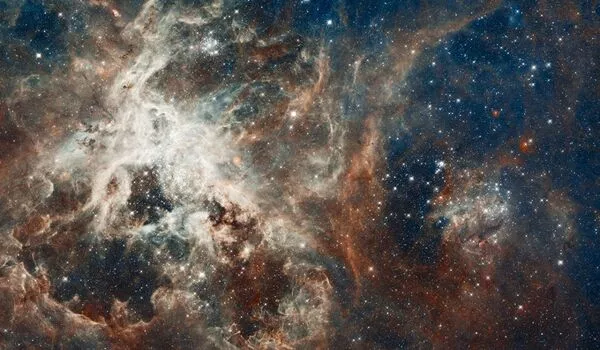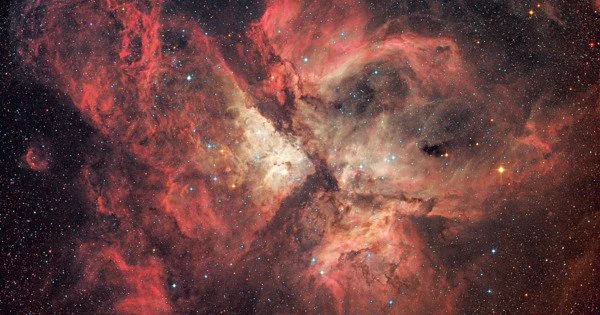Using new observations from the Atacama Large Millimeter/submillimeter Array, astronomers have revealed intricate details of the star-forming region 30 Doradus, also known as the Tarantula Nebula (ALMA). We can now see the nebula in a different light, with wispy gas clouds that reveal how massive stars shape this region.
An astronomical marvel can be found about 170,000 light-years from where you are, which may seem far but is actually quite close on a cosmic scale. It’s a magnificent stellar nursery adorned with stunning swirls and iridescent streaks, illuminating space’s void by violently birthing newborn stars.
“These fragments could be the remains of once-larger clouds shredded by the enormous energy released by young and massive stars, a process known as feedback,” says Tony Wong, who led the research on 30 Doradus, which was presented today at the American Astronomical Society (AAS) meeting and published in The Astrophysical Journal. Originally, astronomers believed that the gas in these areas would be too sparse and too overwhelmed by the turbulent feedback for gravity to pull it together to form new stars. However, the new data show much denser filaments where gravity still plays a role.
Our results imply that even in the presence of very strong feedback, gravity can exert a strong influence and lead to a continuation of star formation. We were expecting to find that parts of the cloud closest to the young massive stars would show the clearest signs of gravity being overwhelmed by feedback.
Tony Wong
“Our results imply that even in the presence of very strong feedback, gravity can exert a strong influence and lead to a continuation of star formation,” adds Wong, who is a professor at the University of Illinois at Urbana-Champaign, USA.
The Tarantula Nebula, located in the Large Magellanic Cloud, a satellite galaxy of our own Milky Way, is one of the brightest and most active star-forming regions in our galactic neighborhood, lying approximately 170,000 light-years away from Earth. Its core contains some of the most massive stars known, some of which are more than 150 times the mass of our Sun, making the region ideal for studying how gas clouds collapse under gravity to form new stars.
“What makes 30 Doradus unique is that it is close enough for us to study in detail how stars are forming, and yet its properties are similar to those found in very distant galaxies, when the Universe was young,” said Guido De Marchi, a scientist at the European Space Agency (ESA) and a co-author of the paper presenting the new research. “Thanks to 30 Doradus, we can study how stars used to form 10 billion years ago when most stars were born.”

While most previous studies of the Tarantula Nebula have concentrated on its center, astronomers have long known that massive star formation occurs elsewhere as well. The team conducted high-resolution observations across a large region of the nebula to better understand this process. They used ALMA to measure the light emission from carbon monoxide gas. This allowed them to map the nebula’s large, cold gas clouds that collapse to give birth to new stars, as well as how they change as massive amounts of energy are released by those young stars.
“We were expecting to find that parts of the cloud closest to the young massive stars would show the clearest signs of gravity being overwhelmed by feedback,” says Wong. “We found instead that gravity is still important in these feedback-exposed regions — at least for parts of the cloud that are sufficiently dense.”
In the image released today by ESO, we see the new ALMA data overlaid on a previous infrared image of the same region that shows bright stars and light pinkish clouds of hot gas, taken with ESO’s Very Large Telescope (VLT) and ESO’s Visible and Infrared Survey Telescope for Astronomy (VISTA). The composition shows the distinct, web-like shape of the Tarantula Nebula’s gas clouds that gave rise to its spidery name. The new ALMA data comprise the bright red-yellow streaks in the image: very cold and dense gas that could one day collapse and form stars.
The new study provides detailed information about how gravity behaves in the star-forming regions of the Tarantula Nebula, but it is far from complete. “There is still much more to be done with this fantastic data set, and we are making it available publicly to encourage other researchers to conduct new studies,” Wong concludes.





